DJI's Spark drone is tiny and fast, but will leave you wanting more

DJI’s Spark drone is an exquisitely-built, incredibly easy-to-fly drone, but 16 minutes of flight time is not enough, especially when the reality is more like 10 to 12 minutes.
There are still so many things to love about DJI’s tiny, selfie-snapping drone. The Spark is the first drone I can effectively control with my hand. It’s also fast, nimble, responsive, intelligent and has a very good camera.
But I struggled to fully test it because the flight time was so short. Having more than one battery is a necessity for this drone.
SEE ALSO: Capture perfect Insta-worthy underwater selfies with this bionic fish
Now that I’ve gotten that off my chest, let’s talk about why you may still want to consider the DJI Spark as your first personal drone, even with its myriad tiny flaws.
Getting started
At 300 grams (0.66 pounds) and 5.6 x 5.6 inches, the Spark comes close to smartphone size. Even with the rotor guards, it easily fits in a small backpack. The compact design is reminiscent of its bigger, foldable brother, the DJI Mavic Pro. The Spark doesn’t fold, but it does offer different chassis colors, a feat none of DJI’s other drones can match.
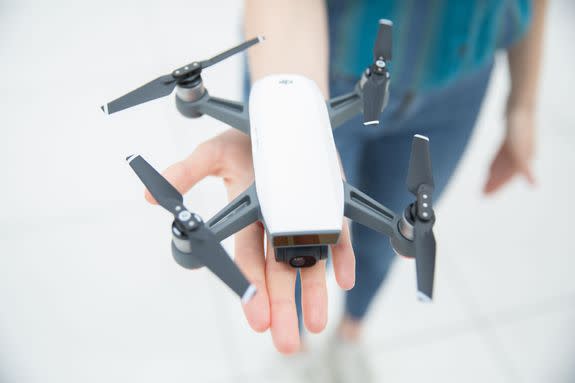
Image: lili sams/mashable
On the front of the drone is the Spark’s object sensor and below that is the 1080p 12-megapixel camera on a 2-axis gimbal (image stability is boosted by a little bit of electronic stabilization).
The bottom features more sensors and short rubber feet for landing. On the rear is a power button (which is actually part of the battery), and, above that, is a hidden compartment for the USB charging port and a microSD slot for storing your recorded footage.
I love the placement and accessibility of these ports. They’re hidden from view, but easy to access. In fact, I wish all DJI’s drones followed this design detail.
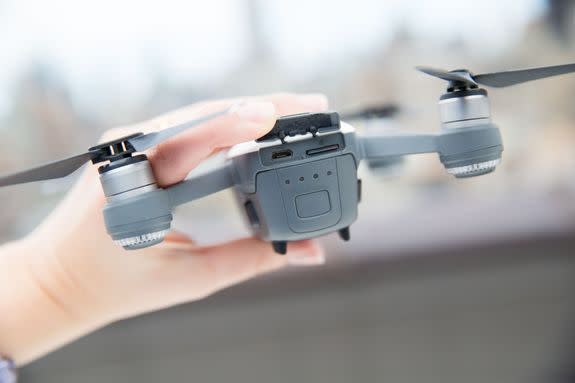
Image: lili sams/mashable
To prepare for flight, you first have to install the DJI Go app on your phone (iOS or Android) and register with DJI to ensure that Spark gets all the relevant flight restriction updates. If you don’t, your flights will be incredibly limited. Even the camera won’t work.
After that, you need only attach the four propellers. As with all other DJI drones, one pair attaches by rotating it clockwise and the other by rotating counter-clockwise. The guards, which I do recommend, attach just as easily. You slip then onto the bottom of each rotor base, twist them onto the stem that attaches the propeller motor to the drone’s body and then close a latch over the stem.
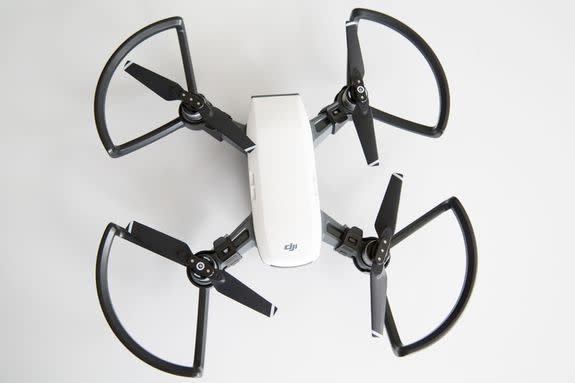
Image: lili sams/mashable
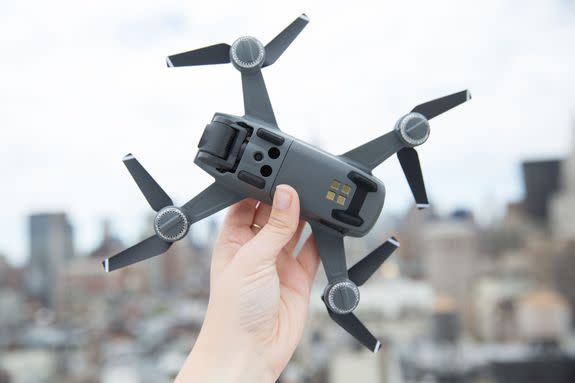
Image: lili sams/mashable
Normally, there’d be another step before flying, but that’s not the case with the Spark. It’s ready to follow your commands even without a connected smartphone or remote control. The Spark is ready to take off from the palm of your hand and respond to simple hand gestures.
I don’t recommend indoor flight for any but the simplest toy drones or expert pilots, but I felt confident I could try a least a few of the Spark’s gesture control tricks in my relatively cavernous office space.
DJI has standardized its power-up procedure across all its drones: one short press on power, then a long one. As soon as I did this, the Spark made a little tone, spun up its internal fan and the four lights, one below each rotor, lit up: The two in the front were red and the two in the back flashed yellow.
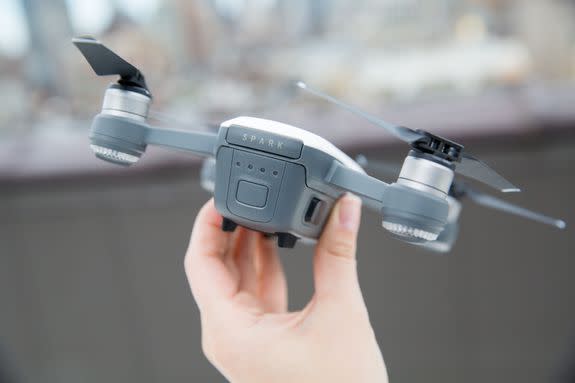
Image: lili sams/mashable
As I prepared to launch the Spark from my hand, I made sure to keep my fingers below the rotor stems; it’s tiny, but those propeller blade could hurt you (if you really get your fingers caught the drone will automatically shut down).
Next, I hit the power button twice to enter gesture-control mode. The Spark’s propellers quickly spun up and a moment later I released my grip and the drone floated up. It hovered in front of my face (about 2 meters off the ground) as the camera tilted up and down, looking for a face (it’s facial recognition is not person specific). Once it found mine, the forward lights turned green.
I put my hand up with the palm facing forward and then slowly moved my hand in all directions. As long as I moved slowly, the Spark followed every move. I held my hands in front of my face, using my fingers to make a rectangle. The green lights flashed red for a few seconds as it counted down to my selfie. Each time I did this, I had to remind myself to stay still for the selfie.
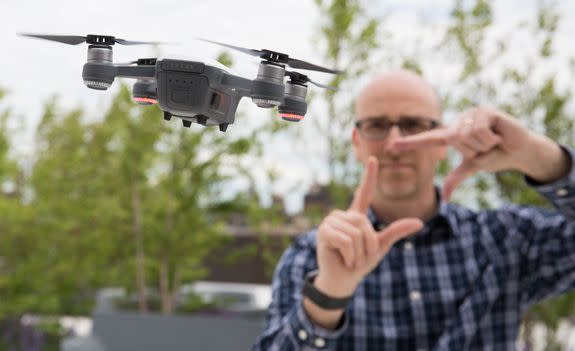
Image: lili sams/mashable
Since I was indoors, I didn’t attempt any more daring gestures (like the wave to send it flying at least 15 feet away). Instead, I raised both of my hands to "beckon" it back. Spark flew slowly toward me and I held my hand underneath it. It flashed red and landed perfectly on my palm. As soon as it touched down, the rotors stopped spinning.
I did this little routine over and over in the office and it worked perfectly.
Outdoors, though, I found the gesture recognition a little less consistent. For one thing, I could not get the drone to recognize the "Away" gesture. When you wave your hand like you’re saying goodbye, the drone is supposed to fly up and backwards roughly 15 feet. (You should never do this indoors because the drone has no rear obstacle avoidance system.)
I kept trying to wave the drone away, but all it would do is shift left and lower itself a bit, clearly misinterpreting my gesture.
Flights in gesture mode are confined to 109 feet away from the launch point. To go further, you have to switch to remote control.
You can, of course, control Spark the old-fashioned way. The drone connects via Wi-Fi to the latest version of DJI’s control software: Go 4.
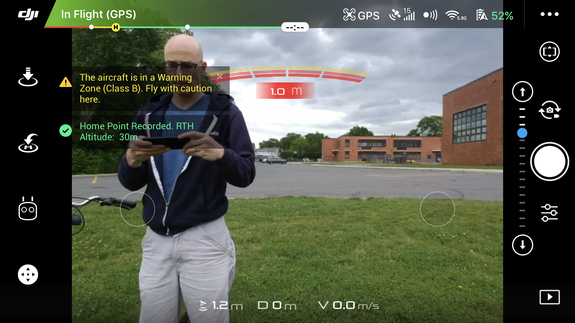
Image: DJI Go
One general note about the software: DJI Go 4’s home screen is the least complicated and intimidating part about it. Every screen below that is relatively complex, which makes more sense when you realize that Go is the smartphone-based flight software used for most of DJI’s other, more pro-level, drones.
The Go app’s home screen includes a lot of useful flight status information, like elevation, and distance from home and speed. There are also self-explanatory controls for takeoff, landing, return to home and remote-control styles. On the right are camera controls including gimbal attitude, photo or video and image settings. The Spark includes a GPS, so it knows where you’re flying and will warn you on screen if it’s in a restricted zone. Behind everything is the Spark drone camera’s point of view.
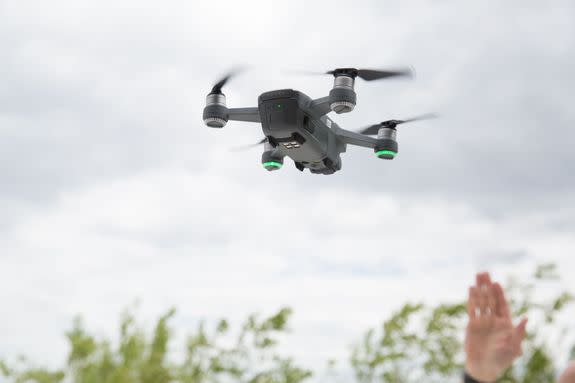
Image: lili sams/mashable
The updated software also adds a bunch of new preset flight patterns, all of which I was anxious to try out. There’s Rocket, which sends the Spark straight up while the camera is pointed straight down; Circle, which has Spark fly in a circle around an object; Dronie, which has Spark simultaneously fly up and backward while still tracking the subject; and Helix, which is a sort of reverse corkscrew flight pattern, while still tracking the subject. To access this level of flight intelligence, though, you have to dig into the menus a bit and disable Beginner Mode.
I wanted to try all of them but, I had to abort half of them mid-flight. Thankfully, the Go app includes big red “X” on the screen so you can stop a pattern and take over flight control at any moment.
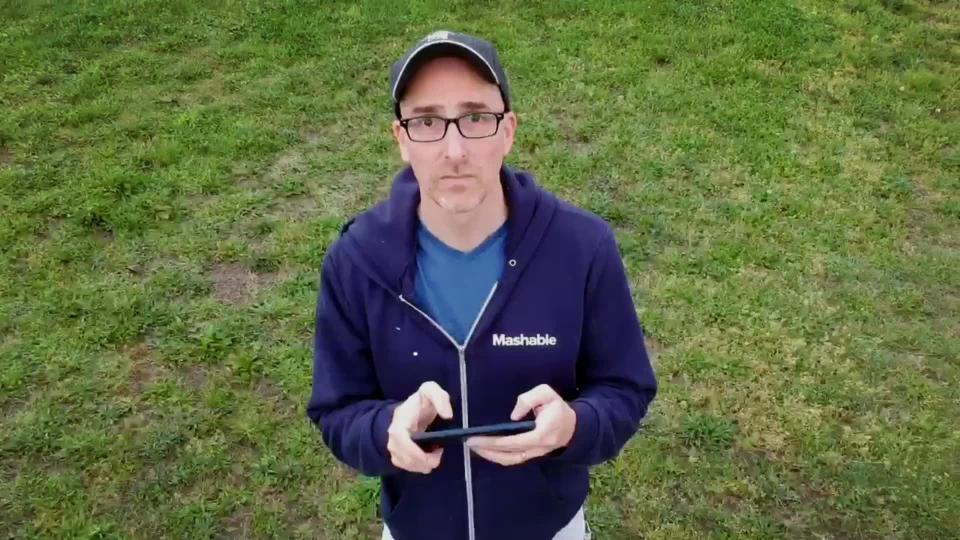
The problem with some of these preset flight patterns is that they’re unusable in anything but the most open space. I was testing on a baseball field (one I’ve often used for drone test flights) and was stunned to see how Helix and Dronie QuickShot patterns almost sent the drone out of the field. Only Rocket, which sends the drone straight up, and Circle, which maintains a radius of about 25 feet, were safe for me to test.
The fix here is simple: Just allow drone pilots to set maximum perimeters for all QuickShots. DJI thinks this will be addressed in a future Go build.
Even though the QuickShot modes were a little bit disappointing, flying Spark with the Go app’s simple on-screen controls was a joy. There are two virtual thumb pads, and you control yaw and altitude with one, and flight speed and direction with the other.
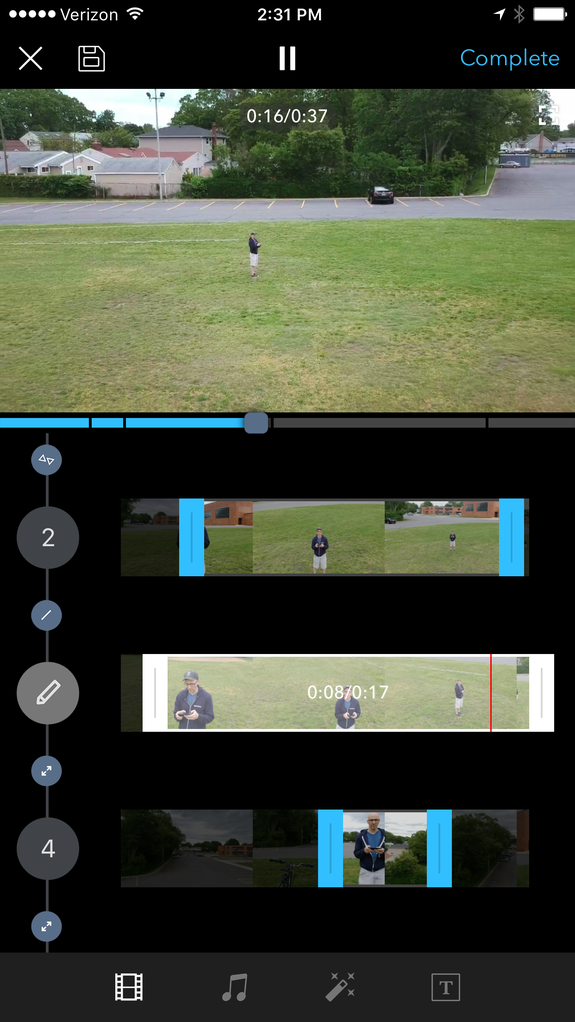
Image: Dji go
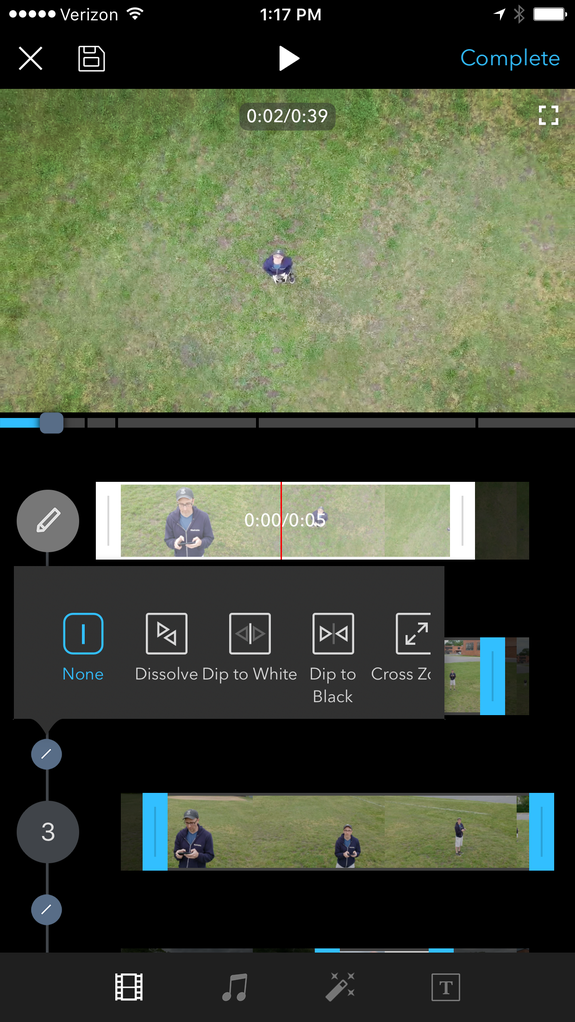
Image: dji go
The DJI Go 4 app now has a built-in video editor that tries to automate the creation and sharing of cool videos from your drone videos and photos, which automatically appear in the editor (you can even add other media from your phone’s storage). It works great if the clips are short, but if you import a long drone video, there’s no way to cut up clips; you can only trim from the start or the ending. Aside from that obvious failing, I like the editor. It has solid editing tools, especially the transitions, canned music, and ability to speed up the video on a gradual curve. The text tool, though, makes no sense since it only includes canned text overlays.
I was moderately impressed with the app and drone’s ability to capture panoramic and shallow focus images. Granted, the software is confusing and once again hides the critical controls in odd places, but the results are promising.
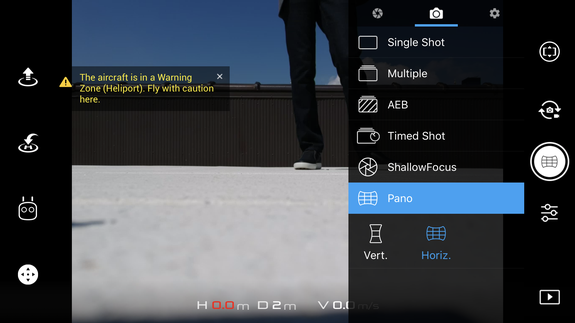
Image: lili sams/mashable
For panoramas, I had to select the camera control menu item and, then stay very still while the drone automatically captured three images that it would then stitch together in software. Similarly, for shallow focus, I had to stand still while the camera did its work. At no time when I was shooting did the camera show me the finished shots. I had to find them under the tiny playback button.
Panoramas look okay, except for the wild distortions on the edge photos. Similarly, shallow focus pictures make iPhone 7 Plus’s Portrait mode edge stitching look absolutely amazing. The edges around me in one photo were almost comically bad. This is something a software update should be able to fix.

Image: lance ulanoff/mashable
The Spark can fly fast, up to 31.5 mph, and I had a great time zipping around the ball field. With beginner mode off, I could also fly over a mile away, though I was careful to keep my Spark in view. For such a small drone, Spark had no trouble navigating a gentle breeze. It did, though, struggle considerably when I flew it on the roof of my office building where I watched it fight the stiff breeze, which also made it harder for the drone to keep track of my face and hands during gesture operations. At one point, the drone got stuck in the air just out of my reach, I somehow coaxed it down to my hand and then tilted the Spark 90 degrees, which instantly shut it down (I love this feature).
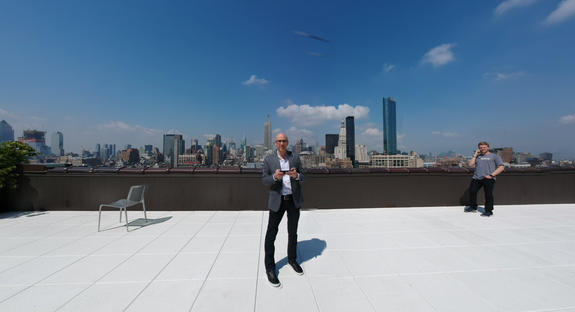
Image: lance ulanoff/mashable
I was having so much fun testing, until the low battery warning started going off at about 19% of battery life. By 10% the drone was automatically heading back home. By my reckoning, I got about 12 minutes of flight time.
Without the benefit of a second battery, this short flight time significantly limited my testing options. I soon realized how much I appreciate the almost extra 10 minutes I get with most of DJI’s other drones.

Image: lili sams/mashable
There is a lesson here, and it relates mostly to price. The DJI Spark costs just $499 — an excellent price — but it's only for the base package, which is the drone and nothing else. An extra $200, though, will get you the propeller guards (they really ought to be in the base package), another set of propellers, a charging base that can simultaneously charge three batteries, a physical remote control and, most importantly, a second intelligent battery (they should include two extra batteries).
$699 is still an excellent price for the package and I can’t see recommending any other package. You simply have to have a spare battery with you if you’re going to truly enjoy this drone.
DJI Spark Drone
The Good
Excellent design. • Filled with intelligence. • Affordable • Good camera • QuickShots simplifies complex flight plans
The Bad
Flight time too short • Software hides key features • Panorama and shallow focus need work • Base price should include propeller guards • Quickshots needs refinement to keep the drone from flying too far away.
The Bottom Line
The DJI Spark drone has so many things going for it, but it needs longer flight time, a better base package, and software polish before we can recommend it.
Bonus: Can drones rake leaves?
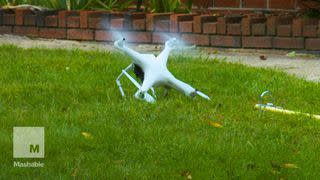

 Yahoo News
Yahoo News 
